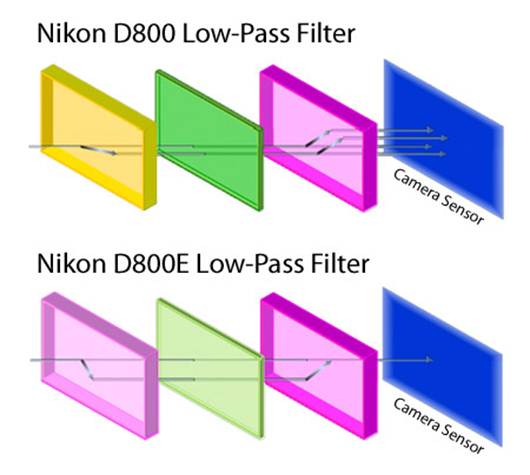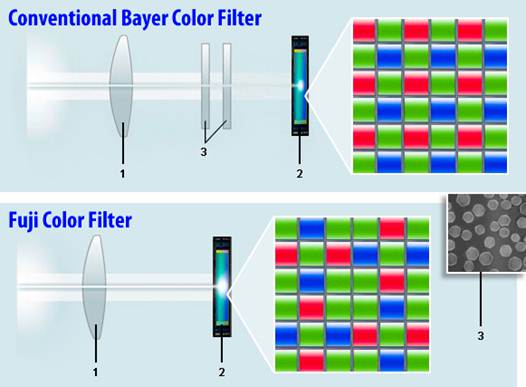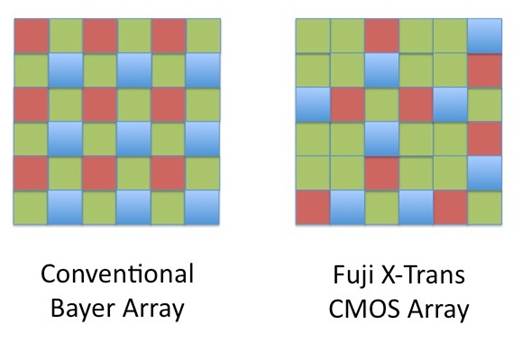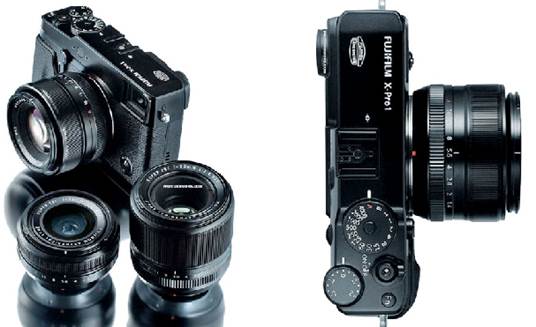It is also recommended that photographers
alter their shooting style when using a camera such as the D800E. This may be
by employing tripod mounting, altering technique, lens choice and aperture.
Also, bear In mind that moiré and false colour are virtually impossible to spot
on a camera's LCD screen and will need to be viewed at 100% magnification on a
computer screen to see the artefacts in the image. Also, JPEG and TIFF shooters
should avoid a D800E as files are processed in-camera and are virtually
impossible to correct later on. The best way to improve an image that shows
moiré or false colour Is to shoot RAW and fix it during post-production, when
the image file is processed.

Nikon
D800 vs D800E Low-Pass Filter
Fujifilm, however, has approached the issue
differently with its X-Pro 1. Rather than simply removing anti-aliasing
properties (and, more importantly, leaving the probability of moiré and false
colour in the images), the company has designed a completely new sensor that
takes its inspiration from Fujifilm's long-established practice and experience
with traditional photographic film. Fujifilm stresses that the new colour
filter array in its sensor completely removes the need for an OLPF.
“Moiré is tackled at its root cause by the
innovative colour filter array of the new sensor," the company explains.
“By enhancing the aperiodicity (randomness) in the array arrangement, the
colour filter minimises the generation of moiré and false colours, eliminating
the necessity for an optical low-pass filter in the lens and enabling the
sensor to capture the full 'unfiltered' resolution and descriptive quality of the
lens.”
The result, according to Fujifilm, is a
compact system camera that outperforms the sensors found in many full-size
DSLRs. So why does moiré occur in photos taken with a digital camera, when it
never appears in photos taken with a silver halide film camera that does not
include optical low-pass filters? Fujifilm stress this “is because silver
halide particles that make up photographic film form a random pattern. Silver
halide particles are an organic compound and naturally have an irregular configuration.
Reproducing and achieving low periodicity, seen in silver halide particles on
photographic film, with a digital sensor, can prevent moiré without having to
use optical low-pass filters. This results in the delivery of the
highest-resolution images."

Fujifilm
X-Trans CMOS sensor vs. conventional CMOS
At the risk of getting too technical, it's
important to understand how moiré occurs inside the camera and how Fujifilm has
eradicated it from its new sensor for the X-Pro 1. Colour filters generally used
in modern camera sensors use something called the Bayer array'. It is a highly
periodic array of 2x2 (4-pixel) grids consisting of one R (red), two G (green)
and one B (blue) pixels, arranged In a regular pattern.
A new 6x6 grid was developed for the X-Pro
1 to break the cyclic nature of the 2x2 array. It has 36 pixels (6x6), creating
a highly complex combination compared to Bayer's four patterns to dramatically
reduce the regularity of the regular-repeating pattern. It has been found that
the complexity of this array is sufficient to fundamentally prevent the
development of moiré in most cases.
When you take a photograph, a sensor
receives light and uses the three RGB filters for colour separation. It also
performs interpolation (resizing) based on the correlation of adjacent pixel
information to create a colour image.

FUJIFILM have developed a new CMOS sensor called the X-Trans
In the Bayer array, each row or column
features only two of the three R.G or B filter pixels. In developing the new
colour filter array, Fujifilm ensured that all rows and columns are laid out
with R, G or B filter pixels resulting in more realistic and accurate colour
representation and removal of 'false colour’.
Incidentally, G (green) pixels are largest
in number in this new colour filter array. Fujifilm focused on G pixels because
green has the highest sensitivity in the visible spectrum (i.e. the most easily
recognised by human eyes). The new colour filter array also has a balanced
mixture of R (red) and B (blue) to enable natural colour reproduction, close to
what the human eye can see.
In real-world terms, this can even result
in images in the colour spectrum that other cameras cannot even produce.
Tatsuya Tanaka is an internationally published nature and astronomical photographer
who was stunned at the results of this new sensor. "The red stars of the
Rosette Nebula, shaped like a rose, are difficult for cameras with low-pass
filters to capture because the red wavelength gets cut off. I was excited about
how those stars would appear with the X-Pro 1, a camera without low-pass
filters installed. It reproduced them well. It easily captured objects that the
human eye could not see in the short exposure time of three minutes. It
reproduces a world that could not be made possible with compact digital
cameras. Tones that could be reproduced with films were difficult to do
digitally, but the X-Pro 1 could reproduce tones in a wide dynamic range from
bright to dark areas."

Fujifilm
X-Pro 1 Mirrorless Camera
So. where is this all leading? These
cameras may not be for absolutely everyone, but there is a distinct market of
both professionals and serious amateurs who will welcome any increase in image
quality. It’s a bizarre phenomenon that, despite constant increases in
megapixel counts and leaps forward in imaging technology, digital cameras are
still susceptible to two serious issues that were never and issue for film -
moiré and false colour. It seems even more odd that, until now, the only way to
correct this was by inserting optical low- pass filters into the camera that
subsequently softened the image. However, with both Nikon and Fujifilm actively
providing alternatives to the standard configuration, all that could be about
to change.
Both of these cameras, while very exciting,
have their own distinct issues.The D800E eliminates anti-aliasing entirely,
delivering optimum image sharpness but exacerbating the problems solved by the
filter. The X-Pro 1, on the other hand, wipes out the moiré and false colour
issues while delivering sharp images - but not everyone will want to invest in
a brand-new system or, more importantly, a compact one. Maybe the solution is
some kind of hybrid, where Fujifilm licence its technology to be employed in
other types of cameras such as DSLRs. This, however, reduces Fujifilm's
competitive advantage and it may not be a technology the company is willing to
give up-just yet.

Faneuill
Hall area in Boston with Fuji X-Pro 1 Fujinon 35mm f/1.4
Whatever happens, it is highly unlikely
that either company (or their competitors, for that matter) are going to rest
on their laurels. The bar has been set for both image sharpness and artefact
reduction. The question is, who will raise it next?